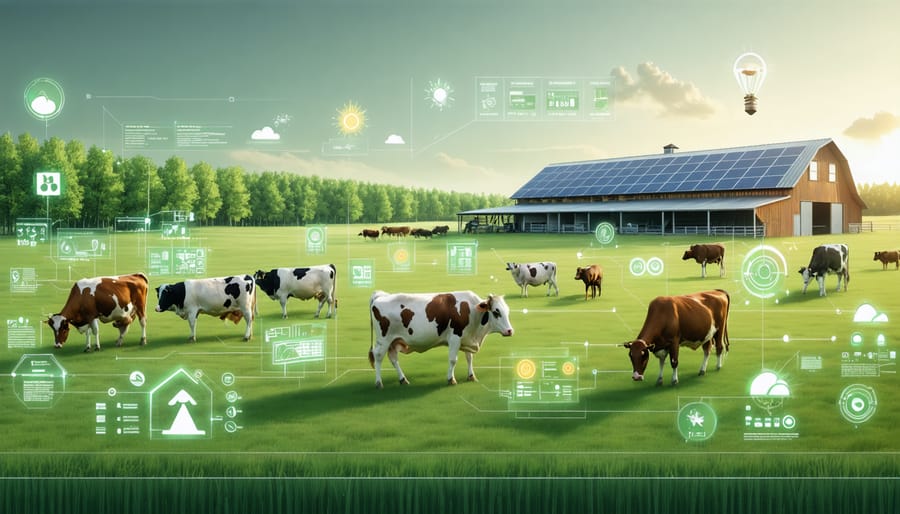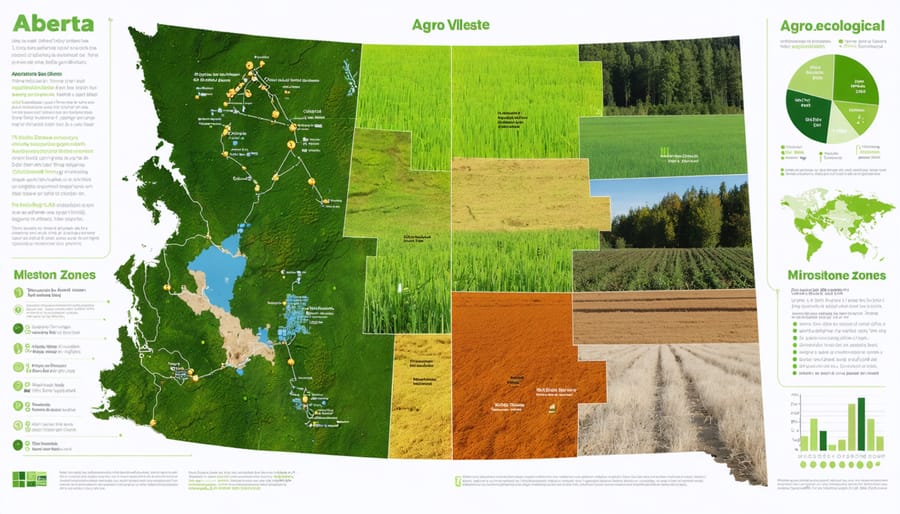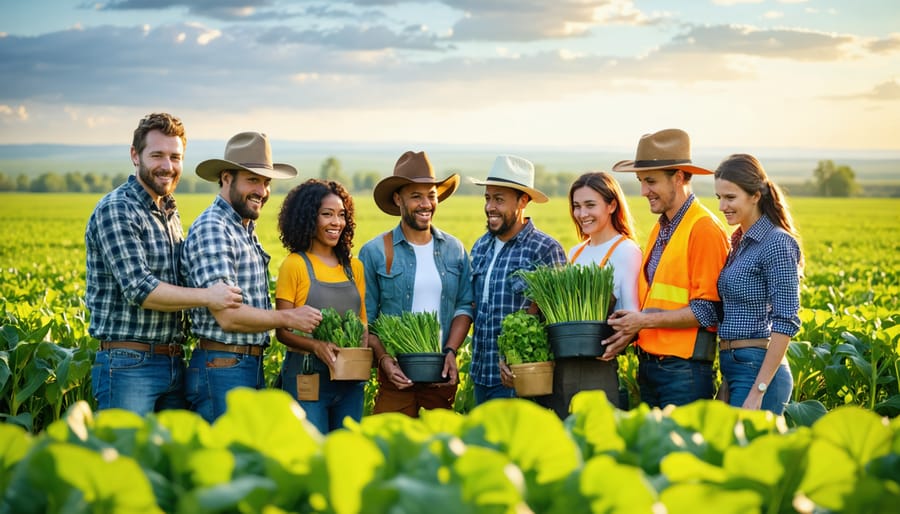Transform your livestock operation into a climate-resilient enterprise by implementing rotational grazing patterns across quarter sections, integrating drought-resistant forage species, and establishing wind shelter belts that protect cattle while sequestering carbon. Alberta’s shifting weather patterns demand immediate adaptation – from adjusting calving seasons to match earlier springs, to developing water management systems that capture snowmelt and summer rainfall efficiently.
Canadian ranchers are uniquely positioned to lead North America’s agricultural climate response. Our grasslands naturally sequester 10-12 tonnes of carbon per hectare annually when properly managed, while innovative feed supplements can reduce methane emissions by up to 30%. Across the prairies, forward-thinking farmers are already combining traditional knowledge with cutting-edge practices, proving that productivity and environmental stewardship can work in harmony.
The solutions are within reach: strategic grazing management, improved feed efficiency, and robust soil health programs not only build climate resilience but also strengthen farm economics. By adapting now, Alberta’s livestock producers can turn climate challenges into opportunities for operational excellence, ensuring our agricultural heritage thrives for generations to come.
Climate-Smart Grazing Systems for Alberta’s Changing Weather
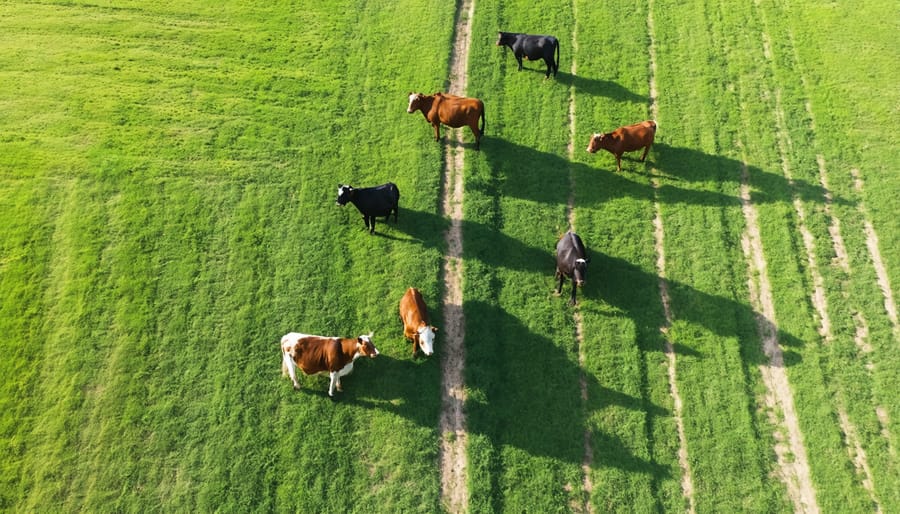
Rotational Grazing Success Stories
Sarah and Tom Henderson of Red Deer County transformed their 800-hectare ranch through adaptive grazing practices, dividing their land into 30 paddocks. After three years, they reported a 40% increase in soil organic matter and doubled their cattle carrying capacity while reducing feed costs by 35%.
In Lacombe County, the Martinez family’s success story showcases the power of strategic rotation. By implementing a 5-day rotation schedule across 20 paddocks, they’ve witnessed remarkable improvements in pasture recovery time and drought resilience. Their innovative approach helped them maintain productivity during the 2021 drought while neighboring farms struggled.
The Berg Brothers near Camrose demonstrate how rotational grazing can work in larger operations. Managing 500 head of cattle, they’ve developed a mobile fencing system that allows quick paddock adjustments based on seasonal conditions. Their soil testing shows a 25% increase in carbon sequestration since implementing their rotation system in 2019.
These success stories share common elements: careful planning, flexible management, and commitment to soil health. Each farm adapted their rotation schedule to their specific landscape and climate challenges, proving that rotational grazing can be successfully implemented across different Alberta farming contexts.
Weather-Based Pasture Management
Effective pasture management in our changing climate requires a flexible approach that responds to weather patterns. Here in Alberta, we’ve seen how unpredictable weather can impact grazing schedules, but with careful monitoring and planning, farmers can optimize their pasture use while protecting their land.
Many successful Alberta ranchers now use weather forecasting apps and soil moisture monitors to make informed grazing decisions. For instance, during prolonged dry spells, reducing grazing intensity and implementing rotational grazing helps preserve grass cover and root systems. After heavy rains, allowing pastures additional recovery time prevents soil compaction and protects vulnerable wet areas.
The key is developing a responsive grazing calendar that can be adjusted based on seasonal forecasts. Consider creating designated “sacrifice paddocks” for extreme weather events, whether it’s drought or excessive rainfall. This protects your primary grazing areas while maintaining herd nutrition.
Local farmer Jim Peterson from Lacombe shares, “We’ve started planning our grazing rotation in two-week blocks rather than strict monthly schedules. This gives us the flexibility to respond to weather changes while maintaining good pasture management practices.”
Remember to monitor grass height and soil conditions regularly. During drought conditions, maintain grass height above 10 centimetres to protect root systems and soil moisture. In wet conditions, watch for signs of pugging and adjust your rotation accordingly to prevent long-term pasture damage.
Feed Management That Reduces Your Carbon Hoofprint
Local Feed Solutions
Local feed solutions play a crucial role in reducing your farm’s carbon footprint while supporting regional agriculture. By sourcing feed from nearby producers, you can significantly cut transportation emissions and strengthen local farming communities across Alberta and beyond.
Many Alberta farmers have successfully implemented local feed strategies. Take Dave Thompson’s cattle operation near Red Deer, for example. By partnering with neighbouring grain farmers, he’s reduced feed transportation distances by 85% and saved approximately $12,000 annually in fuel costs.
Consider these practical approaches to localizing your feed supply:
Establish direct relationships with nearby crop farmers to secure hay, grain, and silage. This often leads to better pricing and reliable supply chains. Many Alberta farmers are finding success with feed-sharing cooperatives, where multiple livestock producers coordinate bulk purchases from local sources.
Growing your own feed crops, when possible, offers the ultimate local solution. Even dedicating a portion of your land to feed production can make a significant difference. For optimal results, focus on climate-resilient crops suited to your specific region.
Don’t overlook alternative local feed sources. Brewers’ grain from regional craft breweries, vegetable waste from nearby processing facilities, and crop residues from local farms can all supplement traditional feed while reducing waste in your community.
Remember to maintain detailed records of feed sources and transportation distances – this data helps track your progress and can be valuable for organic certification requirements.
Methane-Reducing Feed Strategies
Recent research from Alberta’s Livestock Gentec has shown that strategic feed modifications can significantly reduce methane emissions from cattle while maintaining or even improving production efficiency. Several proven strategies have emerged from Canadian studies that farmers can implement on their operations.
Adding legumes like alfalfa and clover to pasture mixtures can reduce methane production by up to 25%. These nitrogen-fixing plants not only lower emissions but also improve forage quality and reduce the need for synthetic fertilizers. Many Alberta ranchers have successfully integrated sainfoin, a legume particularly well-suited to our climate, into their grazing systems.
Incorporating feed additives like seaweed supplements has shown promising results. Studies at Lethbridge Research Centre demonstrate that adding just 0.2% dried seaweed to cattle feed can reduce methane emissions by up to 80%. Local suppliers now offer these supplements specifically formulated for Canadian livestock operations.
Essential oils and tannin-rich forages are gaining attention as natural methane reducers. Farmers in central Alberta have reported success with feeding birdsfoot trefoil, which contains beneficial tannins that improve protein utilization while decreasing methane production.
Feed processing techniques also play a crucial role. Grinding or pelleting feed to optimal particle sizes improves digestibility and reduces methane output. The University of Saskatchewan’s research shows that processing grains to a medium grind (2-4 mm) can lower methane emissions by 15% while maintaining animal performance.
Remember to introduce these changes gradually and monitor your animals’ response. Working with a qualified nutritionist can help develop a balanced approach that meets both environmental and production goals.
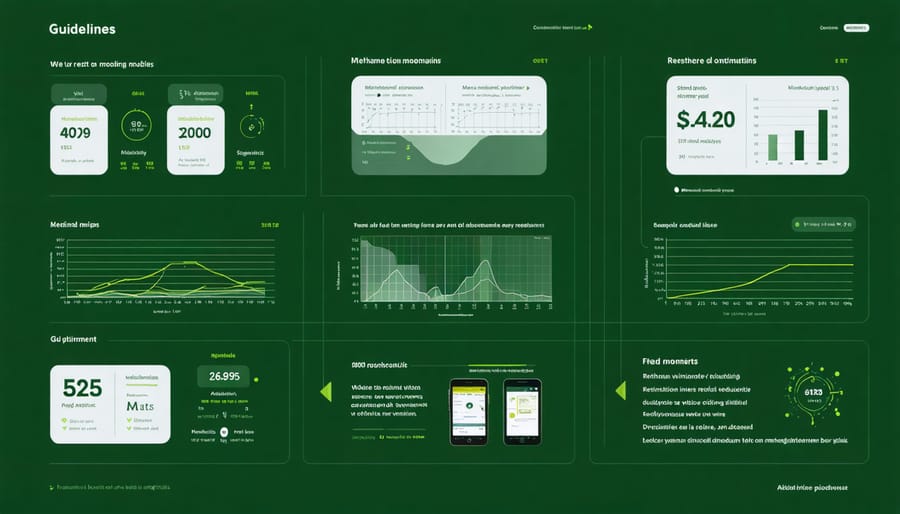
Waste Management Innovation on Alberta Farms
Composting Systems That Work
Effective composting systems play a crucial role in regenerative farming methods and help livestock operations reduce their carbon footprint. For small-scale farms (under 50 hectares), windrow composting proves highly effective. This method involves creating long, narrow piles of organic material approximately 1.5 metres high and 2.5 metres wide, allowing for optimal aeration and decomposition.
Medium-sized operations often benefit from aerated static pile systems, which use perforated pipes to deliver oxygen to the compost pile. This system requires less turning and labour while producing high-quality compost within 3-4 months. Many Alberta farmers have successfully implemented this method, particularly for handling mixed livestock and crop residues.
Larger operations might consider in-vessel composting systems, which, while requiring higher initial investment, offer precise temperature and moisture control. These enclosed systems process material faster and work year-round, even during harsh Canadian winters.
For all farm sizes, incorporating a three-bin system allows for continuous composting throughout the season. The first bin collects fresh material, the second contains actively decomposing matter, and the third holds finished compost ready for field application. This approach ensures a steady supply of nutrient-rich organic matter while managing farm waste efficiently.
Biogas Opportunities
Alberta’s livestock farms are uniquely positioned to tap into biogas production as a sustainable solution for both waste management and renewable energy generation. The province’s high concentration of cattle operations provides an abundant source of organic material that can be converted into valuable biogas through anaerobic digestion.
Many Alberta farmers have already discovered the economic benefits of biogas systems. The Lethbridge Biogas facility, for example, processes manure from local dairy farms to generate enough electricity to power 2,800 homes annually. Beyond energy production, these systems create nutrient-rich digestate that serves as an excellent organic fertilizer, completing the circular farming cycle.
The Alberta government currently offers grants and incentives for farmers interested in establishing biogas operations. Through the Growing Forward 2 program, livestock producers can access funding for feasibility studies and implementation costs. Local success stories include the Veerstra dairy farm near Picture Butte, which reduced its carbon footprint by 25% while creating a new revenue stream through biogas production.
For smaller operations, community-based biogas projects are emerging as viable options. These collaborative initiatives allow multiple farms to share resources and infrastructure costs while maximizing energy production potential. The County of Red Deer’s agricultural services board actively supports farmers in exploring these cooperative opportunities.
Getting started with biogas requires careful planning and consultation with agricultural extension specialists who can help assess your farm’s specific potential and requirements.
Building Climate Resilience Through Better Infrastructure
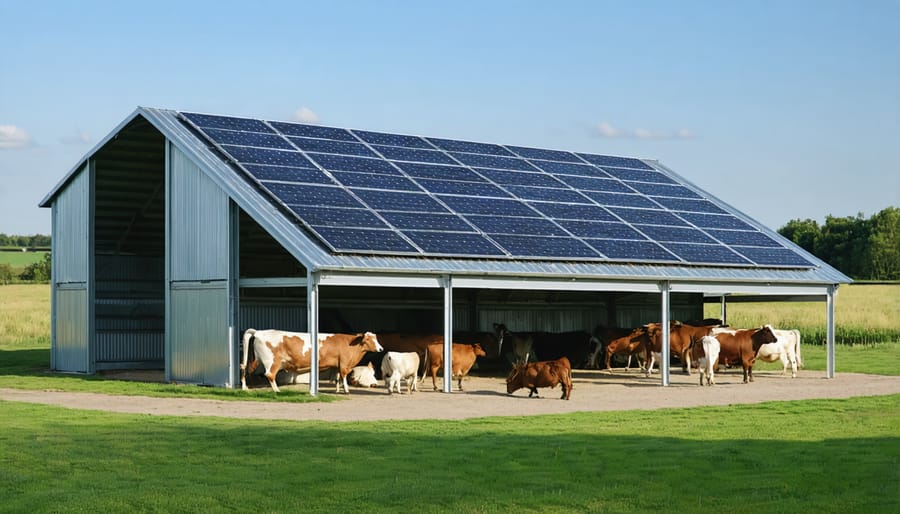
Weather-Ready Shelter Solutions
As Alberta’s weather patterns become more extreme, investing in adaptable shelter solutions is crucial for livestock protection and farm sustainability. Simple yet effective modifications to existing structures can provide significant benefits without breaking the bank.
Consider installing adjustable windbreaks using locally sourced materials like wooden panels or repurposed shipping containers. These versatile barriers can be repositioned seasonally to shield animals from harsh winds while allowing proper ventilation during warmer months. For smaller operations, portable shelters mounted on skids offer flexibility to move with changing weather conditions.
Many Alberta farmers have found success with modified three-sided shelters featuring adjustable side panels. These structures can be opened for summer cooling and closed during winter storms, with costs typically ranging from $2,000 to $5,000 depending on size and materials.
The Lakeland Agricultural Research Association recommends incorporating natural windbreaks through strategic tree planting, which provides long-term protection while enhancing biodiversity. This approach has shown a 20-30% reduction in winter feed requirements for sheltered cattle.
Remember to include proper drainage systems and elevated flooring to prevent moisture accumulation. Simple solutions like gravel pads or recycled rubber matting can significantly improve comfort and hygiene while remaining cost-effective.
Water Management Systems
Efficient water management is crucial for Canadian livestock operations facing climate change challenges. Here in Alberta, we’re seeing more frequent droughts and irregular precipitation patterns, making smart water systems essential for farm resilience.
Consider installing rainwater harvesting systems that can collect and store water from barn roofs and other structures. These systems typically include storage tanks, filtration units, and distribution pipes, providing a reliable water source during dry spells. Many Alberta farmers have found success with above-ground storage tanks that hold 10,000 to 50,000 litres, protecting water supplies from freezing during harsh winters.
Innovative distribution methods like solar-powered pumps and gravity-fed systems can significantly reduce energy costs while ensuring consistent water access for livestock. Automatic waterers with insulation and heating elements prevent freezing and maintain steady water flow throughout winter months.
For pasture management, rotational grazing paired with strategic water point placement helps prevent soil compaction and overgrazing near water sources. Installing multiple watering stations throughout your grazing areas, ideally within 200 metres of anywhere in the paddock, encourages even grazing patterns and reduces the environmental impact of livestock concentration.
Remember to regularly monitor and maintain these systems, particularly during seasonal transitions, to ensure reliable operation year-round.
As we’ve explored throughout this article, Canadian livestock farmers have both the opportunity and responsibility to address climate change through sustainable farming practices. The path forward requires a balanced approach that combines traditional farming wisdom with innovative solutions.
Start by conducting a thorough assessment of your farm’s current emissions and identifying areas for immediate improvement. Consider implementing rotational grazing systems, which have shown promising results across Alberta’s varied landscapes. Many local farmers have successfully reduced their carbon footprint while maintaining or even improving productivity through these methods.
Connect with your local agricultural extension office and join farmer-led initiatives in your region. The strength of our farming community lies in sharing knowledge and supporting one another through these transitions. Take advantage of available funding programs and resources specifically designed for Canadian farmers implementing climate-smart practices.
Remember that every farm is unique, and there’s no one-size-fits-all solution. Focus on changes that make sense for your operation, starting with manageable steps like improving feed efficiency or enhancing pasture management. Document your progress and share your experiences with fellow farmers – your successes and challenges can provide valuable insights for others on similar journeys.
By taking action today and planning for tomorrow, we can build more resilient farming operations that benefit both our agricultural community and the environment. Together, we’re securing a sustainable future for Canadian livestock farming.

